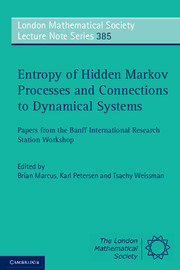 Entropy of Hidden Markov Processes and Connections to Dynamical Systems
Entropy of Hidden Markov Processes and Connections to Dynamical Systems Book contents
- Frontmatter
- Contents
- Introduction
- 1 Hidden Markov processes in the context of symbolic dynamics
- 2 On the preservation of Gibbsianness under symbol amalgamation
- 3 A note on a complex Hilbert metric with application to domain of analyticity for entropy rate of hidden Markov processes
- 4 Bounds on the entropy rate of binary hidden Markov processes
- 5 Entropy rate for hidden Markov chains with rare transitions
- 6 The capacity of finite-state channels in the high-noise regime
- 7 Computing entropy rates for hidden Markov processes
- 8 Factors of Gibbs measures for full shifts
- 9 Thermodynamics of hidden Markov processes
7 - Computing entropy rates for hidden Markov processes
Published online by Cambridge University Press: 05 June 2011
- Frontmatter
- Contents
- Introduction
- 1 Hidden Markov processes in the context of symbolic dynamics
- 2 On the preservation of Gibbsianness under symbol amalgamation
- 3 A note on a complex Hilbert metric with application to domain of analyticity for entropy rate of hidden Markov processes
- 4 Bounds on the entropy rate of binary hidden Markov processes
- 5 Entropy rate for hidden Markov chains with rare transitions
- 6 The capacity of finite-state channels in the high-noise regime
- 7 Computing entropy rates for hidden Markov processes
- 8 Factors of Gibbs measures for full shifts
- 9 Thermodynamics of hidden Markov processes
Summary
Abstract. In this article we want to show how certain analytic techniques from dynamical systems, and more particularly thermodynamics, can be used to give new explicit formulae for entropy rates for certain hidden Markov processes. As a byproduct, the method gives potentially very accurate numerical approximations to the entropy rate.
Introduction
We want to describe an approach to studying entropy rates for certain hidden Markov processes. Our motivation for studying this problem comes from a previous approach to Lyapunov exponents for random matrix products, which we shall also briefly describe. We were first introduced to the connection between Lyapunov exponents and entropy rates by the article of Jacquet et al. [8]. However, there is a close analogy which probably dates back as far as the work of Furstenberg [3] and Blackwell [1]. They studied Lyapunov exponents and entropy rates, respectively, by considering associated stationary measures. For simplicity, we shall restrict ourselves to the specific case of binary symmetric channels with noise. However, there is scope for generalizing this method to more general settings.
Our aim is to present new explicit formulae for the entropy rates and, thus, by suitable approximations, give an algorithm for the explicit computation. The usual techniques for studying entropy rates tend to give algorithms which give exponential convergence (reflecting the use of positive matrices and associated transfer operators). The techniques we describe typically lead to a faster super-exponential convergence.
- Type
- Chapter
- Information
- Entropy of Hidden Markov Processes and Connections to Dynamical SystemsPapers from the Banff International Research Station Workshop, pp. 223 - 245Publisher: Cambridge University PressPrint publication year: 2011
- 3
- Cited by
